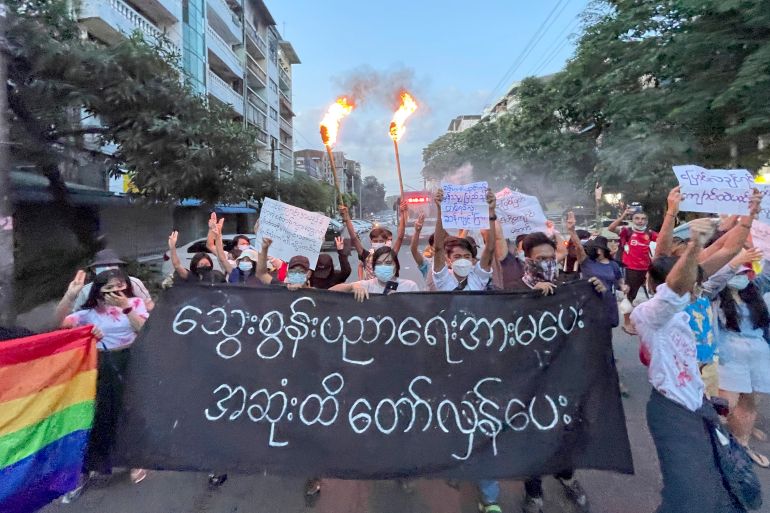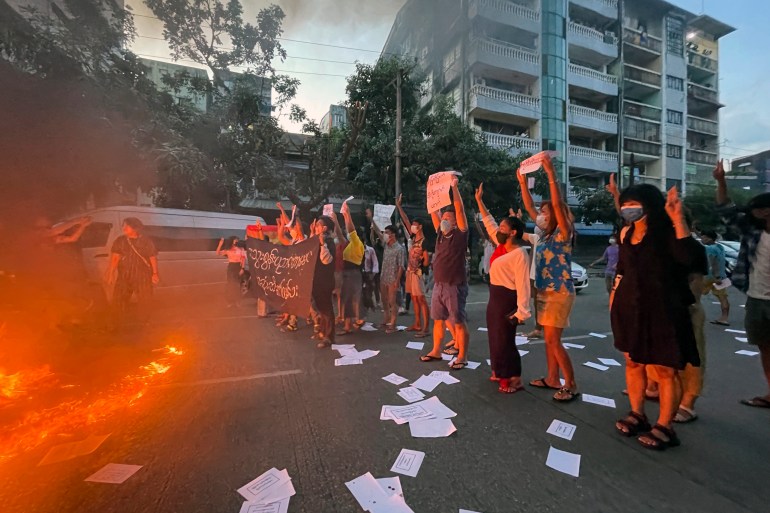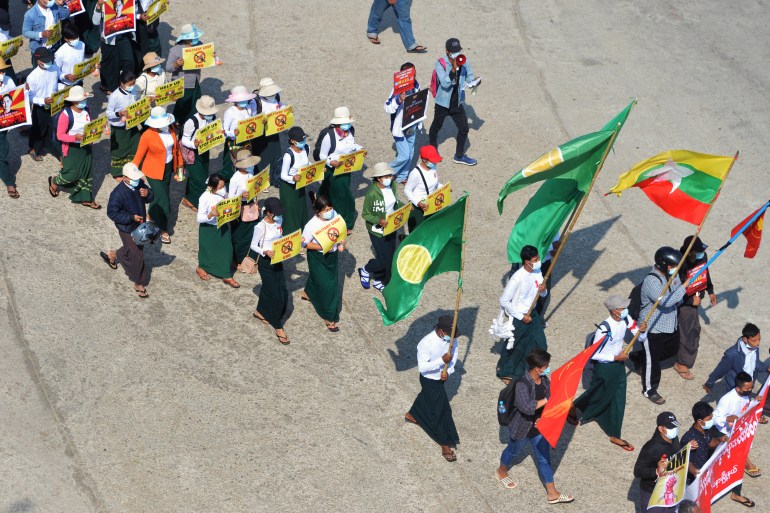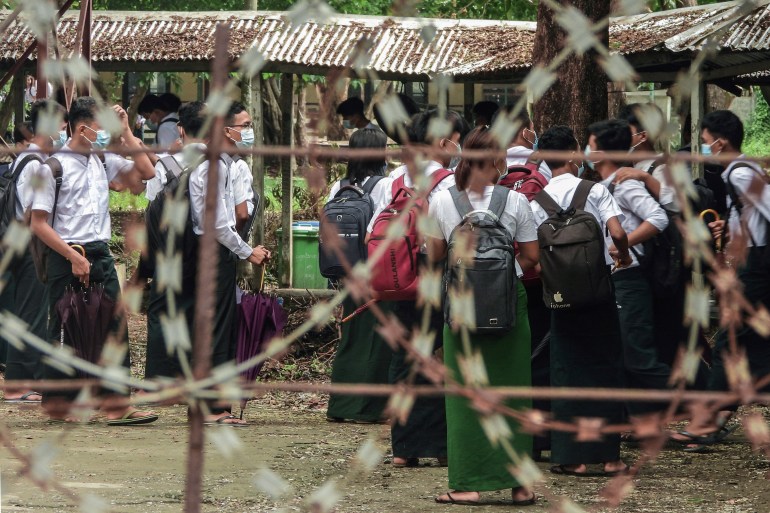Myanmar students boycott classes following school reopening
Schools reopened on November 1, but with high security risks and an unwillingness to support the leadership, few students are attending.

As schools reopen across Myanmar, classrooms remain almost completely empty with students and teachers refusing to attend.
“I haven’t been going to school because there have been explosions at schools recently. None of my friends are going either,” said Chika Ko, a 16-year-old high school student from Pyay, a town in Bago state, who asked that her real name not be used for fear of reprisal.
Keep reading
list of 4 itemsMyanmar charges Aung San Suu Kyi over alleged election fraud
UN Security Council calls for an end to violence in Myanmar
Myanmar army ‘arresting aid workers, destroying food stocks’
“My school hasn’t been attacked yet but when I hear of explosions at other schools it makes me so scared and so I am staying home.”
Chika Ko says that her school normally has 600 students, but only about 20 have shown up in the last couple of weeks.
Since the military announced the reopening of schools on November 1, after a nationwide closure in July due to COVID-19, many students like Chika Ko have refused to attend, both to protest against the generals who seized power in a coup on February 1 but also out of fear they could be subject to an attack.
Nay Zin Oo is a 48-year-old parent from Yangon. He has one child in primary school and two in secondary school but has refused to let any of them attend class while the military is in control of the country.
“The schools are operated by the military and as a revolutionary, I refuse to send any of my children,” said Nay Zin Oo who asked that his real name not be used for fear of reprisal.
“If we, parents, choose to send our children to school it means we are supporting the military. I will only send them once a different party wins over.”
He believes that boycotting schools is a powerful way of protesting against the military as he fights for the return to the civilian government that was elected in November 2020.

He also wants to push back against the country’s outdated education system.
“In the current education system [students] won’t even gain very much, so I don’t see the point in sending them. When students graduate here, the degree is only useful in our country, and even then it isn’t very useful,” said Nay Zin Oo, who graduated with a dual degree in engineering and physics, but now works as a taxi driver. With little changes made to the basic curriculum in the last 20 years, he points to his own background as evidence of the failures of the current system.
Attacks on both sides
November 1 is not the first time schools have reopened to poor attendance in Myanmar since the military seized power.
Most schools had been closed at the time of the coup due to COVID-19, but in late spring the military announced that they would reopen on June 1. However, hardly any students went to classes because most were participating in the strike movement.
Teachers and students were some of the first to lead the Civil Disobedience Movement (CDM) – Myanmar’s anti-military protest movement – boycotting classes and refusing to participate in the military’s efforts to reform the education system. By June, more than half of Myanmar’s 400,000 teachers had reportedly gone on strike to join the CDM.
“The military has been pressuring teachers to go to school in an effort to shut down the Civil Disobedience Movement,” said Min Htet, an executive member of the Basic Education Union, a group working to reform the country’s education system, who asked that her real name not be used for fear of reprisal.
“Many teachers have since resigned but others have felt they have no choice but to go into school.”
Those who have kept working, have not been spared the violence increased by the coup.
Following the November 1 reopening, the perceived support for the leadership from teachers who have not participated in the boycott has made them targets for extreme, non-military groups. Last week, the head teacher of a school in Mandalay was shot dead while at home, while on November 5 a teacher from Yangon was killed while in a taxi on her way to school.
Some of the attacks have been claimed by armed groups who are using violence to discourage support for the military. The November 5 attack, for instance, was claimed by a Yangon-based group called Generation Z Defence Force who alleged that the teacher had been threatening students and feeding the military information, and therefore needed to be stopped.

Many of these resistance groups claim to be part of, or affiliated with, units of the People’s Defence Force (PDF), loose and decentralised armed groups of the National Unity Government, a parallel administration opposing the military, although many seem to be acting independently. The NUG has condemned the use of violence against civilians, claiming it should only be used in “self-defence.”
“I think the PDFs are trying to scare students away so we will protest with them. But both PDFs and the military are now taking such extreme sides,” said Chika Ko. “Even the PDFs are now saying that if we don’t join with them it means we support the military, and they are threatening us.”
Standing up to the military
The military has also contributed to fears around safety in schools. With their history of attacking teachers and students involved in CDM and the presence of armed soldiers around school perimeters and in classrooms, many students and teachers are terrified they could come under attack.
In May alone, more than 100 schools were attacked by security forces, according to data collected by Save the Children and this number has only continued to increase in the months since.
During the weekend, two high school teachers from Mandalay, who had refused to work under the military, were beaten and arrested for supporting the strike movement, and on November 12, a computer training school in Mandalay linked to a charity affiliated with detained civilian leader Aung San Suu Kyi was set on fire.
While the November 1 reopening was for primary, middle, and secondary schools, there has also been talk that universities could reopen as soon as December, but most of the older cohort of students have already decided that they too will continue with their boycott.
“I have already decided that when they open universities I will not be attending,” said Way Yan Pyo, the secretary of the Sagaing Student Union, who had only been studying for a few weeks when the coup took place.
“I don’t want to graduate in a military system, especially one that isn’t recognised internationally. I would rather wait until they change the curriculum but I don’t think they will change it anytime soon so in the meantime I have joined a local PDF.”
Sagaing state in northwestern Myanmar has become one of the epicentres of violence between the military and resistance groups, with many young people caught in the crossfire. The chairperson of Way Yan Pyo’s union was abducted in September and has not been heard from since. To protect themselves, as well as to fight back against the generals, Way Yan Pyo and many of his classmates and friends have joined the resistance movement, picking up arms to fight.

For now, it seems that most students, and their parents, are united in protest, aware of what they might be sacrificing by not going to school, but determined to stand up to the military in any way they can.
Parents like Nay Zin Oo, who lived through the last period under military rule, know it could take some time, but they will not be giving in or giving up anytime soon.
“Even if it takes years, I would rather teach my children at home myself instead of sending them to a school under the military,” he said.